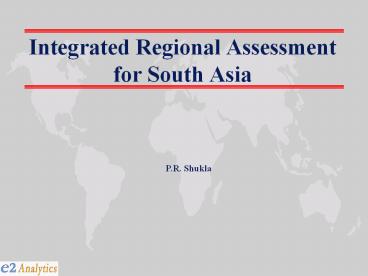Integrated Regional Assessment for South Asia PowerPoint PPT Presentation
1 / 35
Title: Integrated Regional Assessment for South Asia
1
Integrated Regional Assessment for South Asia
P.R. Shukla
2
The South Asia region
- Consists of Seven Countries
- India, Pakistan, Bangladesh, Sri Lanka, Nepal,
Bhutan and Maldives. - Area- 3 of the world total
- Population- About a quarter of the worlds
population. - Among the fastest growing developing country
regions
3
Economic Indicators
4
Population Projections
5
Global climate change and South Asia
6
Current climate
- Predominantly a Land of Tropical monsoon
Climate. - Has a variety of climatic regions
- Arid climate in west India and east Pakistan
- Warm-humid in Sri Lanka, Maldives
- Distribution of rainfall rather than temperature
delineates the climate of one region from the
other
7
South Asia Geo-Political Regions
8
Factors contributing to Climate change
- Natural
- El Nino (effect on monsoon)
- Anthropogenic
- Population growth
- Land use change and forestry
- Energy and emission patterns
9
Total Energy Consumption Shares (1995)
10
Total and Per Capita CO2 Emissions
11
CO2 Emission Distribution
45
35
35
5
55
2
13
10
Power
Industry
Other industries
Road
Other transport
Steel
Other sectors
Cement
- Power sector has 90 emissions from 50 plants
- Industry emissions are relatively dispersed. 10
districts emit 70 (including 5 steel plants)
62 contribution to Indias CO2 Equivalent GHG
emissions
12
Coal consumption, CO2 and SO2 emissions
13
Point Source Carbon Emissions (India)
- Largest 10 sources contribute 40 of power sector
and 18 of all India emissions - 40 sources contribute 85 (power) 39 (all
India)
14
Climate change impacts
15
Human health impacts
- Heat wave-Northern plains of India and Desert
areas of India and Pakistan. - Malaria and Dengue Fever-Tropical Regions of Sri
Lanka and India. - Phytoplankton blooms-South Asian Coastlines.
16
Impact on Agriculture
- Changing pattern of monsoons would affect
Agricultural yields. (both ve and - ve) - Yields of crops near their maximum temperature
tolerance would be adversely affected. - The region is susceptible to diseases, pests and
weeds which show a strong correlation wit
changing climatic conditions.
17
Energy, industry and transport
- These impacts can be described under
- Directly sensitive to climate change
- Dependent on climate sensitive resources
- Markets sensitive to Climate Change
18
Directly sensitive to climate
- Coastal industries
- Hotels
- Coastal industries (salt manufacturing,
fisheries) - Coastal infrastructure
- Ports
- Railway networks (e.g. Konkan Railways)
- Roads
- Inland infrastructure
- Hilly roads and bridges
- Dams
- Change in energy consumption
- Space cooling in Building and transportation
sectors - Due to changed irrigation requirements
19
Dependent on climate-sensitive resources
- Agro-industries
- Food
- Beverages
- Industries dependent on forestry
- Building sector
- Paper
- Power generation
- Shipping
20
Markets sensitive to climate change
- Energy infrastructure
- Change in transport demand
- Migration
- Agro-product movements
- Insurance sector
21
Konkan Railway
22
Power Plants
23
Integrated Modelling Framework
24
Integrate Diverse Concepts
- Diverse socio-economic scenarios
- Macro and micro-economies
- Local and regional boundaries
- Short and long time horizons
- Local and global environmental concerns
- Rural and urban perspectives
- Regional emissions and impact assessment
- Probability and Decision under uncertainty
- Technology
25
Uncertainty and security issues
26
Uncertainty in geographic factors
- Monsoons
- Sensitive to sea surface temperature and land
surface conditions - Sea level
- Magnitude of the rise
- Areas that would be threatened need to be
identified. - Water resources
- Changes in ground water levels
- Changes in summer flows of several rivers that
originate from glaciers.
27
Uncertainty in socio-economic factors
- Population growth
- Fast changing fertility and mortality rates
across the region. - Migrations resulting from natural disasters like
cyclones, floods and droughts. - Urbanization
- High rate of urbanization is causing pressure on
existing infrastructure. - Change in energy resource use pattern
- Economic and social development
- Level of economic and social development varies
across the region.
28
Energy Security Issues
- Least Expensive Pipeline Route to North India
- Piped Gas 3.5/GJ
- LNG Import 5/GJ
- Coal Import 2.5-3/GJ
- Substantive Mitigation at below 50/ Ton of Carbon
29
Vulnerability and Adaptation Issues
30
Vulnerability
- Agriculture
- Sector highly dependent on Rainfall
- Food Security
- Predominantly Subsistence farming
- Industry
- Tourism
- Agro industries would be affected
- Infrastructure
- Ports, roads, rail, and bridges in low lying
coastal areas would be affected.
31
Adaptation strategy
- Agriculture
- Changes in the cropping system.
- Developing crop varieties that are more resistant
to changing climatic conditions. - Developing alternatives like aquaculture.
- Water resources
- Rain water harvesting and water conservation.
32
Forest Cover as percentage of Total Land Area
33
Adaptation Strategy Contd.
- Coastal Regions
- Movement of threatened population.
- Promotion and development of risk management to
protect ecology of the region. - Forests
- Establishment of corridors to assist the
"migration" of ecosystems. - Land-use management, and plantations.
- Encourage sustainable agricultural practices and
restoration of degraded areas.
34
Policy Assessment
35
Policies and Measures for Impacts
- Coastal zone policies
- Infrastructure policies
- Adaptation measures
- Insurance packages

